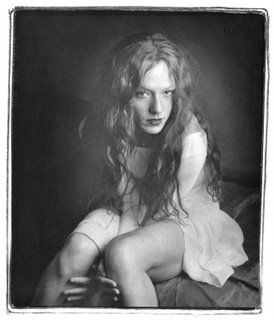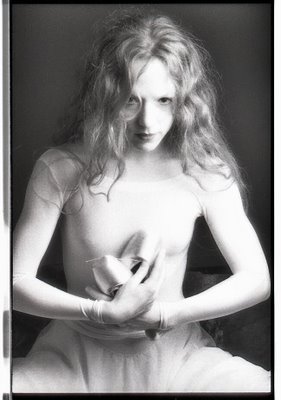Previsualizing The Unpredictable - Minor White
Tuesday, June 10, 2008

There is a neat little book in my library (printed in 1968) that I look at and read in sections every once in a while. It is a book about a vanishing era of photography. The subject is and was called the Zone System. The man who pioneered most of it was Ansel Adams but the man who wrote about it in a Zen kind of way was the American Photographer and teacher Minor White. Minor White's little book is called Zone System Manual - Previsualization - Exposure - Development - Printing.
Minor White's idea was that you could approach a scene and take a photograph with your mind's eye. If you were really good at it and you had the technical practice then the image in your mind would be realized with camera and film. This was the photographic equivalent of the architect who sees an empty space and can already see the finished building before the cornerstone is laid.
This act of previsualization comes to me infrequently. When it happens it is sheer joy. Sometimes my subject will pose. I will shoot a Polaroid and then a couple of pictures with film and stop. At one time I would take rolls and rolls of film. But in these rare moments one exposure is all I need. I know that the image in my head will be exactly the one on film. Of course the chances of this happening are greater when I reduce the variables such as doing it in my studio, using a specific light I am comfortable with and using a tried and true technique.

You would think that this predictability could be boring in the end. Consider what Minor White says in his introduction:
The ultimate objective is to be able to previsualize as one wishes, spontaneously or leisurely whichever best serves the purposes at hand. There is a difference in the penetrating power of an image made in a burst of naive enthusiasm and those made in a flash of trained intuition. The first is adolescent, the latter mature and sometimes wise.
Minor White then eloquently writes on the subject of previsualization and the development of intuition:
Photography serves all kinds of image-making talent in mankind wiht an equality that almost amounts to an holy indifference. It does not distinguish the sleeper from the trancendentalist; it serves the first with its automatic mechanicalness, the second with its power to evoke th sense of light in images. It gives the spark of creativity in anyone a fine chance to grow. And from those people who have grown to love photography and master it have come three psychological concepts: Equivalence (Alfred Stieglitz), Previsualization (Edward Weston and Ansel Adams) and Response. )( The latter sometimes goes under the name of "reading photographs".) These concepts give affirmation to individuals who pursue consciousness and wakefulness by way of photography.
Forty years ago a Mexican chemical engineer, radio station owner and amateur photographer, Ingeniero Luis de la Rosa took me under his wing and revealed to me The Zone System. We photographers who have at the very least a minimum understanding of it (that's me) will always capitalize it (The Zone System!) on principle. It was de la Rosa who taught me to use a hand held light meter in the incidence mode (measuring the light that falls on the scene) as opposed to the usually innacurate reflected mode (it measures light bouncing off from our scene).
One day, I remember it so vividly that I know we were having coffee in the Sanborns on Calle Amberes in Mexico City, de la Rosa handed me a yellow box of Kodak b+w infrared film. His instructions were as follows:

1. Don't open the container except in absolute darkness.
2. Load it into your camera in absolute darkness.
3. Expose it using a No 25 deep red filter.
4. Infra red light focuses at a different wave length so when you focus with your lens then "unfocus" to the little red mark on your lens's focusing ring.
5. Remove the film only in darkness.
6. Develop it in Kodak HC-110. If this developer was good enough for Ansel Adams it should be good enough for you.
Of course I didn't follow the man's advice and I opened the container during the day. Light slipped in and fogged the film. I had to start again. But once I had gotten the hang of it I was rewarded by exposures that were not always predictable. And every once in a while serendipity gave me completely unplanned yet wonderful shots. Infra red film is a grainy film which reacts to objects, plants and people in how much infrared light they reflect. Decidious tree leaves will photograph a startling white. Blue skies and white clouds will look like a b+w Randolph Scott western, nuit américaine, day for night.
But it is in shooting nudes and portraits that infrared film becomes a constant and almost unpredictable surprise. I am sure that Minor White might have modified his little book to include infrared film. He had that mystical connections. We mortals simply have to adjust to its randomness. It was infrared film that made Lauri Stallings look like she was jumping in the air when she was really sitting on a stool.
One predictable result of using infrared film is that anything red always appears much lighter or white. This means that lips in portraits appear white and my subjects might look dead, or worse, undead. The solution is to use purple lipstick. Since purple is in the opposite end of colour spectrum it renders dark. I have been looked at strangely at London Drugs the times I have gone to the makeup counter to ask for purple lipstick.
The single most unpredictable variable in using infrared film is the way that my flashe's catchlights might not appear reflected on my subject's eyes. It seems to depend on certain angles (the angle between the light and the elevation of the eyes) that only de la Rosa might have explained to me. As example I show here one exposure of Lauri Stallings scanned in three different ways. The images range from angel to witch. Of course infrared film renders Stallings's hair as near white. In this third version I colourized to increase the idea of the witch and to remove it as far from the first image of the angel.

Kodak recently discontinued its infrared film. I have a few boxes in my freezer. Then I discovered that my Corel Paint Shop Pro X photo program has an uncanny conversion of b+w to b+w infrared. It is so good that it manages to look more like infrared film than authentic infrared film. You are now able to previsualize a scene or portrait and get what's in your mind every time.
At least that's what I thought. But notice in the above three photographs the curious look in Stallings's eyes. Then look at the picture below (left) which is standard b+w and then a Corel Paint Shop Pro X modified to look like infrared (below, right). There is something missing in the eyes.


Compare those two (I am satisfied with the normal b+w version on the left) with the true infrared below. I think that while previsualization is a good thing it is so much fun to be surprised!







